This is an old revision of this page, as edited by GreenC bot (talk | contribs) at 17:09, 23 July 2020 (Rescued 1 archive link. Wayback Medic 2.5). The present address (URL) is a permanent link to this revision, which may differ significantly from the current revision.
Revision as of 17:09, 23 July 2020 by GreenC bot (talk | contribs) (Rescued 1 archive link. Wayback Medic 2.5)(diff) ← Previous revision | Latest revision (diff) | Newer revision → (diff) Anti-Jewish riot in Chișinău, Russian Empire from April 19–21, 190347°0′00″N 28°55′00″E / 47.00000°N 28.91667°E / 47.00000; 28.91667
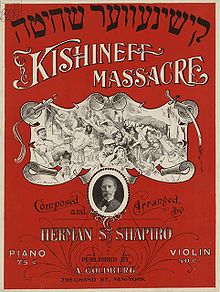
The Kishinev pogrom was an anti-Jewish riot that took place in Kishinev (modern Chișinău, Moldova), then the capital of the Bessarabia Governorate in the Russian Empire, on April 19–21 [O.S. April 6–8] 1903. Further rioting erupted in October 1905. In the first wave of violence, beginning on Easter Day, 49 Jews were killed, a number of Jewish women were raped and 1,500 homes were damaged. American Jews began large-scale organized financial help, and assisted in emigration. The incident focused worldwide attention on the persecution of Jews in Russia and led Theodor Herzl to propose the Uganda Scheme for resettlement of the Jews.
First pogrom (1903)
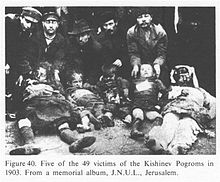
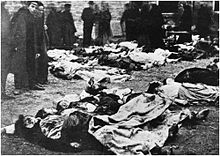
The most popular newspaper in Kishinev, the Russian-language anti-Semitic newspaper Бессарабец (Bessarabetz, meaning "Bessarabian"), published by Pavel Krushevan, regularly published articles with headlines such as "Death to the Jews!" and "Crusade against the Hated Race!" (referring to the Jews). When a gentile Ukrainian boy, Mikhail Rybachenko, was found murdered in the town of Dubossary, about 40 km (25 mi) miles north of Kishinev, and a girl who committed suicide by poisoning herself was declared dead in a Jewish hospital, the Bessarabetz paper insinuated that both children had been murdered by the Jewish community for the purpose of using their blood in the preparation of matzo for Passover. Another newspaper, Свет (Svet, "Light") made similar insinuations. These allegations sparked the pogrom.
The pogrom began on April 19 (April 6 according to the Julian calendar then in use in the Russian Empire) after congregations were dismissed from church services on Easter Sunday. In two days of rioting, 47 (some put the figure at 49) Jews were killed, 92 were severely wounded and 500 were slightly injured, 700 houses were destroyed, and 600 stores were pillaged. The Times published a forged dispatch by Vyacheslav von Plehve, the Minister of Interior, to the governor of Bessarabia, which supposedly gave orders not to stop the rioters, but, in any case, no attempt was made by the police or military to intervene to stop the riots until the third day.

The New York Times described the first Kishinev pogrom:
The mob was led by priests, and the general cry, "Kill the Jews," was taken-up all over the city. The Jews were taken wholly unaware and were slaughtered like sheep. The dead number 120 and the injured about 500. The scenes of horror attending this massacre are beyond description. Babes were literally torn to pieces by the frenzied and bloodthirsty mob. The local police made no attempt to check the reign of terror. At sunset the streets were piled with corpses and wounded. Those who could make their escape fled in terror, and the city is now practically deserted of Jews.
The Kishinev pogrom captured the attention of the international public and was mentioned in the Roosevelt Corollary to the Monroe Doctrine as an example of the type of human rights abuse which would justify United States involvement in Latin America. The 1904 book The Voice of America on Kishinev provides more detail as does the book Russia at the Bar of the American people: A Memorial of Kishinef.
Second pogrom (1905)
A second pogrom took place on October 19–20, 1905. This time the riots began as political protests against the Tsar, but turned into an attack on Jews wherever they could be found. By the time the riots were over, 19 Jews had been killed and 56 were injured. Jewish self-defense leagues, organized after the first pogrom, stopped some of the violence, but were not wholly successful. This pogrom was part of a much larger series of 600 pogroms that swept the Russian Empire at the time.
Russian response
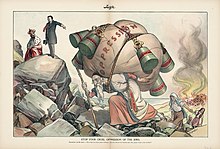
The Russian ambassador to the United States, Count Arthur Cassini, characterised the first outbreak as a reaction of financially hard-pressed peasants to Jewish creditors in an interview on May 18, 1903:
The situation in Russia, so far as the Jews are concerned is just this: It is the peasant against the money lender, and not the Russians against the Jews. There is no feeling against the Jew in Russia because of religion. It is as I have said—the Jew ruins the peasants, with the result that conflicts occur when the latter have lost all their worldly possessions and have nothing to live upon. There are many good Jews in Russia, and they are respected. Jewish genius is appreciated in Russia, and the Jewish artist honored. Jews also appear in the financial world in Russia. The Russian Government affords the same protection to the Jews that it does to any other of its citizens, and when a riot occurs and Jews are attacked the officials immediately take steps to apprehend those who began the riot, and visit severe punishment upon them."
There is a memorial to the 1903 pogroms in Kishinev.
Aftermath
American media mogul William Randolph Hearst "adopt Kishinev as little less than a crusade", according to Stanford historian Steven Zipperstein. As part of this publicity, Hearst sent the Irish nationalist journalist Michael Davitt to Kishinev as "special commissioner to investigate the massacres of the Jews", becoming one of the first foreign journalists to report on the pogrom.
Due to their involvement in the pogrom, two men were sentenced to seven and five years imprisonment respectively and a further twenty-two to one or two years.
This pogrom was instrumental in convincing tens of thousands of Russian Jews to leave for the West or Palestine. As such, it became a rallying point for early Zionists, especially what would become Revisionist Zionism, inspiring early self-defense leagues under leaders like Ze'ev Jabotinsky.
-
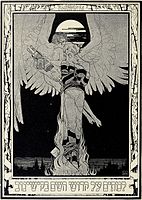 Imprinting honoring the "Kishinev Martyrs", by Ephraim Moses Lilien.
Imprinting honoring the "Kishinev Martyrs", by Ephraim Moses Lilien.
-
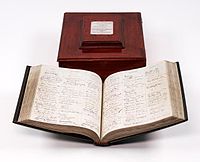 A rejected petition to the Tsar of Russia by US citizens, 1903, now kept at the US National Archives
A rejected petition to the Tsar of Russia by US citizens, 1903, now kept at the US National Archives
Cultural references

Russian authors such as Vladimir Korolenko wrote about the pogrom in House 13, while Tolstoy and Gorky wrote condemnations blaming the Russian government—a change from the earlier pogroms of the 1880s, when most members of the Russian intelligentsia were silent. It also had a major impact on Jewish art and literature. After interviewing survivors of the Kishinev pogrom, the Hebrew poet Chaim Bialik (1873–1934) wrote "In the City of Slaughter," about the perceived passivity of the Jews in the face of the mobs. In the 1908 play by Israel Zangwill titled The Melting Pot, the Jewish hero emigrates to America in the wake of the Kishinev pogrom, eventually confronting the Russian officer who led the rioters.
More recently, Joann Sfar's series of graphic novels titled Klezmer depict life in Odessa, Ukraine, at this time; in the final volume (number 5), Kishinev-des-fous, the first pogrom affects the characters. Playwright Max Sparber took the Kishinev pogrom as the subject for one of his earliest plays in 1994. The novel The Lazarus Project by Aleksander Hemon (2008) provides a vivid description of the pogrom and details its long-reaching consequences.
References
- The Kishinev Pogrom of 1903: A Turning Point in Jewish History, Monty Noam Penkower
- ^
 Rosenthal, Herman; Rosenthal, Max (1901–1906). "Kishinef (Kishinev)". In Singer, Isidore; et al. (eds.). The Jewish Encyclopedia. New York: Funk & Wagnalls.
Rosenthal, Herman; Rosenthal, Max (1901–1906). "Kishinef (Kishinev)". In Singer, Isidore; et al. (eds.). The Jewish Encyclopedia. New York: Funk & Wagnalls.
- "The pogrom that transformed 20th century Jewry". The Harvard Gazette. April 9, 2009. Retrieved March 26, 2016.
- Chicago Jewish Cafe (September 20, 2018), Are Jewish men cowards? Conversation with Prof. Steven J. Zipperstein, retrieved October 8, 2018
- Philip Ernest Schoenberg, "The American Reaction to the Kishinev Pogrom of 1903." American Jewish Historical Quarterly 63.3 (1974): 262-283.
- ^ Corydon Ireland (April 9, 2009). "The pogrom that transformed 20th century Jewry". harvard.edu. The Harvard Gazette.
- In the Shadow of the Struggle, Erwin Birnbaum
- Davitt, Michael (1903). Within The Pale. London: Hurst and Blackett. pp. 98–100.
- Jewishgen.org, The Kishinev Pogrom of 1903; with online resources.
- Klier, John (October 11, 2010). "Pogroms". YIVO Encyclopedia of Jews in Eastern Europe. yivoencyclopedia.org. Retrieved April 17, 2018.
- "Jewish Massacre Denounced". The New York Times. April 28, 1903. p. 6.
- "The voice of America on Kishineff, ed. by Cyrus Adler". Retrieved March 26, 2016.
- "Russia at the Bar of the American People". Retrieved March 26, 2016.
- "Current Literature: A Magazine of Contemporary Record (New York). Vol. XXXV., No.1. July, 1903. Current Opinion. V.35 (1903). p. 16". babel.hathitrust.org.
- "Picasa Web Albums - Ronnie - kishinev". Archived from the original on June 6, 2015. Retrieved March 26, 2016.
- ^ Zipperstein 2015, p. 372.
- Beatty 2017, p. 125.
- Zangwill, Israel (2006). From the Ghetto to the Melting Pot: Israel Zangwill's Jewish Plays : Three Playscripts. Wayne State University Press. p. 254. ISBN 9780814329559. Retrieved April 17, 2018.
- Weingrad, Michael (Spring 2015). "Drawing Conclusions: Joann Sfar and the Jews of France". Jewish Review of Books. Retrieved April 17, 2018.
- Sparber, Max (3 December 2014). "Staged reading of play by Max Sparber: Kishinev". MetaFilter. Retrieved 17 April 2018.
- Hemon, A., (2008). The Lazarus project. New York: Riverhead Books
Bibliography
- Beatty, Aidan (2017). "Jews and the Irish nationalist imagination: between philo-Semitism and anti-Semitism". Journal of Jewish Studies. 68 (1): 125–128. doi:10.18647/3304/JJS-2017.
{{cite journal}}: Invalid|ref=harv(help) - Zipperstein, Steven J. (2015). "Inside Kishinev's Pogrom: Hayyim Nahman Bialik, Michael Davitt, and the Burdens of Truth" (PDF). In Freeze, ChaeRan Y.; Fried, Sylvia Fuks; Sheppard, Eugene R. (eds.). The Individual in History: Essays in Honor of Jehuda Reinharz. Waltham, Massachusetts: Brandeis University Press. ISBN 9781611687330.
{{cite book}}: Invalid|ref=harv(help)
Further reading
- Schoenberg, Philip Ernest. "The American Reaction to the Kishinev Pogrom of 1903". American Jewish Historical Quarterly 63.3 (1974): 262–283.
- Judge, Edward H. Easter in Kishinev: Anatomy of a Pogrom. NYU Press 1992.
- Zipperstein, Steven J. Pogrom: Kishinev and the Tilt of History. Liveright Publishing March 2018.
External links
- Are Jewish men cowards? Interview in Chicago Jewish Cafe with Prof. Steven Zipperstein, the author of "Pogrom: Kishinev and the Tilt of History."
- Kishinev Pogrom unofficial commemorative website
 Rosenthal, Herman; Rosenthal, Max (1901–1906). "Kishinef (Kishinev)". In Singer, Isidore; et al. (eds.). The Jewish Encyclopedia. New York: Funk & Wagnalls.
Rosenthal, Herman; Rosenthal, Max (1901–1906). "Kishinef (Kishinev)". In Singer, Isidore; et al. (eds.). The Jewish Encyclopedia. New York: Funk & Wagnalls.- Penkower, Monty Noam (2004). "The Kishinev Pogrom of 1903: A Turning Point in Jewish History". Modern Judaism. 24 (3): 187–225. JSTOR 1396539.
- Resources about the pogrom